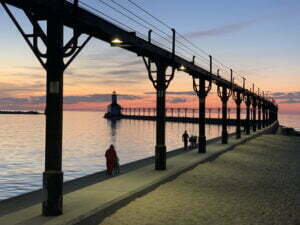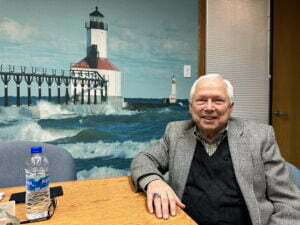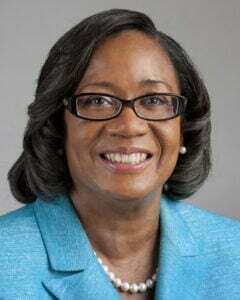City braces for unprecedented change as double-track project leads way to development

Michigan City is on the fast track — make that double track — for rapid growth. Estimates are the population could grow to 40,000 people by 2030 or 2035.
The impact of the $649 million Double Track Northwest Indiana project to speed South Shore Line passenger train travel between Chicago and Michigan City is massive. A commute of about an hour each way makes living in Michigan City and working in Chicago attractive — the benefits of a downtown job’s high salary while also enjoying the lower taxes and small-town atmosphere here.
Michigan City offers a beautiful Lake Michigan beach, lighthouse and zoo at Washington Park. Indiana Dunes National Park’s Mount Baldy; Blue Chip Casino, Hotel and Spa; and Lighthouse Place Premium Outlets, an outdoor mall, are also among top tourist attractions.
The arts scene is vibrant, too, with playhouses, Lubeznik Center for the Arts and Barker Mansion, which is undergoing extensive renovation, and a lot of public art. In 2022, a permanent exhibit honoring suffragist Naomi Anderson, an African American born in Michigan City, was dedicated at Westcott Park.
The promise of easy access to Chicago has developers flocking to the city.
“We’re getting a lot of outside interest,” Mayor Duane Parry said.
If every residential development in the pipeline is built, the city could see 3,500 to 5,000 new residents within a decade, said Clarence Hulse, executive director of Economic Development Corp. Michigan City.

Once in a lifetime
Over the next five years, $750 million in development is planned for the city’s downtown.
“This is not something a small town gets to do every day,” Hulse said, so outside experts are being hired to provide legal and construction expertise.
Hulse’s rapid-fire list of what’s underway downtown is breathtaking.
The city’s $100 million station block will be built over two years, with construction set to begin any day. It includes a parking garage with more than 500 spaces, 220 apartments, plus commercial and retail space, Hulse said.
One of the city’s requirements for the new development was that the terra cotta facade from the former train station be preserved and incorporated into the new structure. The facade was carefully dismantled for future use.
The “You Are Beautiful” sign site where the police station and a newspaper office once stood is set to become a $240 million hotel development with two luxury hotels, condos and retail space. The 12-story development near the entrance to Washington Park will offer Lake Michigan views. It will even include two pools, one of them on the rooftop, Parry said. The pool could be used for ice skating in the winter, he added.

The City Council soon will vote on tax-increment financing district bonds for the project. State tax credits also are expected to be granted. Construction is slated to begin at the end of the third quarter.
“This time next year, we should have three projects well underway,” Parry said in December.
Among the future projects planned for the city is workforce housing at the old Memorial Hospital site bordered by Pine Street, Michigan Boulevard, Fifth and Sixth streets. Hulse’s office will need to relocate, too. For the right price, even City Hall could be sold, Hulse said. It’s on prime real estate, at Franklin Street and U.S. 12, across from the new hotel complex.
With all this development, downtown could stretch all the way from the lakefront to Ames Field, the local football stadium, Councilwoman Angie Deuitch said. She sits on the city’s Redevelopment Commission and the Transit Development District steering committee for the nonprofit One Region.
She sees the train station complex as the anchor for expanding the increasingly vibrant downtown.

Hulse hopes downtown residential developments will spread into the east and west sides of the city, where additional housing is needed, especially single-family homes.
Parry hopes more single-family homes could be added in the area where Marquette Mall stands, near the intersection of U.S. 421 and U.S. 20.
He’s also concerned about single-family homes that have been carved up for multi-family units.
“It’s not good for the neighborhood to have single-family homes turn into two-, four- or six-flats,” he said.
Code enforcement officers are told to be aggressive in enforcing the zoning law, Parry added.
Legacy issues

Police Chief Steve Forker said it used to be easy to patrol downtown at night. Hardly anyone was there. But now that business is booming in the city, that’s no longer the case.
Crime has been an issue in the city. City-Data.com says the crime rate in 2018 was 1.5 times greater than the U.S. average.
The city also has a high poverty rate, with an average of $47,197 household income, according to the U.S. Census Bureau.
City leaders also have made it a priority to address these disparities.
Parry, who is seeking a second term, said he remains focused on bringing jobs to the city.
Deuitch, who also is running for mayor this year, is pursuing a grant to improve the lives of people on the city’s east and west sides.
“We’ve got the transit development district dropped in the middle of these most impoverished areas in town,” she said. “We have to figure out a way to balance the neighborhoods that are adjacent to (it).”
Deuitch is concerned about food insecurity. There are no grocery stores on the east and west sides.
“We just want fresh fruits and vegetables,” she said.
Small shops like bodegas and pantries would help. Expanding the Salvation Army backpack program for school children to include fresh vegetables is another approach.
“There’s best practices for all this stuff,” she said. “Someone’s done it already.”
Bus shelters and sidewalks are important, especially for neighborhoods near U.S. 421 and U.S. 20.
“That’s a safety issue,” she said. “They can walk to work, but we’ve got to create the safer environment to walk to work.”
Chief Forker was appointed in October to change the police department’s strategy, Parry said.
That includes hiring 14 more officers to fill positions that are fully funded, Forker said. Recruitment, however, is a problem nationally, and Michigan City is no exception. The department lost officers last year to nearby municipalities, including South Bend, Porter County and Chesterton.
Forker’s strategy includes using a new recruitment team to have officers share how much they like working for the department. The team will actively recruit potential officers.
The department is launching a marketing effort, too, to help tell its story. It’s more than high-profile arrests, but how officers interact with the community.
Using grant money, the department’s officers carry new basketballs, baseballs and soccer balls in their cars. If they see a bunch of kids playing and don’t have a call to respond to, officers are encouraged to throw a ball to the kids and ask to join them in a game. With full staffing, officers would be more likely to have free time for those games.
Full staffing also would mean increasing targeted enforcement in areas that have seen an increase in calls for service. The detective bureau had 12 officers assigned to it when Forker was a detective. Now it has just six.
La Porte County approved a public safety income tax in 2022, with some of that money going to the Michigan City Police Department. That, too, will help.
The city is joining others in installing gunshot detectors and license plate readers to apprehend offenders more quickly. Already, the department has used neighboring departments’ cameras to catch people with warrants who drive into the city, Forker said.

Workforce initiatives
While an increase in population will increase demands on the city’s officers, it also will increase demand for jobs.
The city already has some big employers.
Last summer, roofing company GAF dedicated its $34.5 million distribution center. The company said the roofing materials production facility in Michigan City, which dates to 2000, is worth about $300 million. The company is planning a line of roofing materials with solar panels built in, and some of that production could come to Michigan City after it’s tested elsewhere.
In November, HealthLinc announced construction of a new state-of-the-art clinic immediately east of the Ivy Tech Community College campus. Estimated cost is more than $15 million, HealthLinc CEO Beth Wrobel said.
The new 39,000-square-foot building will include 33 exam rooms, two procedure rooms, 12 dental rooms and a community center. It will offer medical, dental, behavioral health, optometry, chiropractic, obstetrics and pharmaceutical services.
HealthLinc plans to collaborate with Ivy Tech on training future health care workers.
Ivy Tech is hoping to gain approval from the General Assembly to construct a new building on its campus at about the same cost. The existing building, a former hospital, would be razed after the new one opens. The Michigan City project is No. 2 on the Ivy Tech wish list, behind an Indianapolis project.
The top floor of the proposed Ivy Tech building would be devoted to health care instruction, Chancellor Aco Sikoski said.
Ivy Tech works closely with the city’s employers to train people for future careers. So does Michigan City Area Schools.
The city is considered the air compressor capital of the nation, based on the number of employers and jobs in that industry. There’s a Compressed Air Academy at Michigan City High School to train students for jobs in that industry. Classes offer dual credit with Ivy Tech.

“We ask ‘what do we need to do to be responsive to the workforce and business needs of our community,’” said Superintendent Barbara Eason-Watkins, who has won awards for innovation and excellence.
Michigan City Area Schools acquired the former Brown Mackie College building on U.S. 20 and is transferring some of the career and technical education programs at the AK Smith Career Center to that facility.
The district also is planning to open classrooms for early childhood learning there. During the next year, five classrooms will open. The first two were slated to open in January or February with the others ready for the new school year in August.
The new facility will train childcare workers as well as young children. Eason-Watkins, who sits on the EDCMC board, said providing additional childcare options is essential to meeting the needs of employers and workers as well as young children.
With a median age of 37.2 years, Michigan City is set on the future, and educating the leaders and workers of tomorrow will secure its success.
Click here to read more from the February-March 2023 issue of Northwest Indiana Business Magazine.


